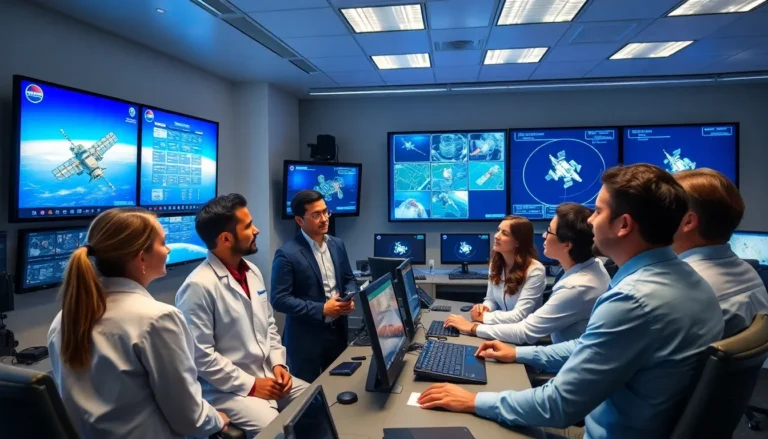When you think about space, do you imagine astronauts floating around in silver suits or maybe Star Wars? Well, hang onto your helmets because new space technology is turning those dreams into hard facts. This isn’t just science fiction anymore: it’s happening faster than you can say “interstellar travel.” With cutting-edge innovations emerging every day, the cosmos is becoming more accessible, with the excitement of groundbreaking advancements waiting just beyond our atmosphere. Ready to be amazed? Let’s blast off into the world of new space technology.
Table of Contents
ToggleOverview of New Space Technology Innovations

The realm of new space technology is fascinating and ever-evolving. Innovations weave their way through the fabric of aerospace engineering, bringing new possibilities for exploration and communication. Think of SpaceX’s reusable rockets or advances in satellite technology that have completely transformed communications and global connectivity.
Companies and governments alike are racing to adopt these technologies, making space travel not just a dream for the elite but a tangible opportunity for many. Innovations like 3D printing in zero gravity or artificial intelligence-driven spacecraft are redefining the rules of engagement with the universe.
From Earth observation satellites that monitor climate change to robots designed for Mars missions, these technological leaps are rewriting our understanding of what we can achieve beyond our planet.
Current Trends in Space Technology
Current trends in space technology reveal a shift toward greater collaboration and commercialization. Space agencies are increasingly partnering with private companies to pursue ambitious projects. The trend of launching satellites is booming, with companies like Planet Labs deploying fleets that provide images of every part of the Earth daily.
Also, miniaturization is a key focus. Smaller satellites, or CubeSats, are becoming prevalent due to their lower launch costs and ability to deploy clusters that can provide richer data than single units. The race to reduce size without sacrificing functionality has opened avenues for universities and startups to compete in the space sector.
Sustainability is another significant trend. As the number of operational satellites increases, so does the concern for space debris. Innovative solutions, such as debris removal technologies and design strategies that minimize end-of-life debris, are becoming critical.
Spacecraft and Launch Systems
Spacecraft design is hitting new horizons, quite literally. With advancements in propulsion systems, spacecraft are being designed to travel farther than ever. Ions thrusters and other non-chemical propulsion technologies are making their mark, providing efficient options for long-duration missions.
The innovation doesn’t stop at propulsion. Launch systems are evolving too, with companies like Rocket Lab focusing on providing dedicated small satellite launch services. These smaller, more frequent launches allow for flexibility and adaptability in deploying new technologies and experiments into space.
Also, the concept of in-orbit servicing is becoming a reality. Imagine refueling satellites or repairing them while orbiting Earth, now that’s a game changer. Such capabilities not only extend the life of current spacecraft but also reduce the need for constant new launches.
Satellite Technology Advancements
Satellite technology is advancing at lightning speed, propelling us into the next era of connectivity and data exchange. High-throughput satellites are enhancing internet speeds across the globe, especially in remote areas where cable infrastructure is lacking.
In the world of Earth observation, a swarm of nano-satellites can be deployed to provide real-time data on natural disasters, crop health, and urban development. The capabilities of artificial intelligence are augmenting how we process this data, allowing for quicker and more accurate decision-making.
Besides, communication satellites are embracing laser technology to transmit data at unprecedented speeds, making it possible for networks to handle higher volumes of data than ever before. Satellite constellations, such as those from Starlink, are paving the way for global internet coverage, fundamentally transforming accessibility.
Impact of Artificial Intelligence on Space Exploration
Artificial intelligence is taking center stage in space exploration, serving as the brain behind data collection and analysis operations. Imagine autonomous robots exploring the Martian surface without constant human oversight. AI algorithms help process data from vast numbers of sensors and optimize mission operations dynamically.
Also, AI assists in predictive maintenance for spacecraft, ensuring they function effectively throughout long missions. This leaves mission control free to focus on strategic endeavors rather than mundane checks and preparations.
The integration of AI is even evident in mission planning. By simulating various outcomes, space agencies can devise efficient strategies that maximize resource use while minimizing risk.
The Role of Commercial Space Companies
Commercial space companies are not just participants: they are leaders in space technology. Firms like SpaceX have set benchmarks by reducing launch costs and revolutionizing reusability. NASA is partnering with these private entities to leverage their innovations and drive projects like the Artemis program.
Also, ventures like Blue Origin aim to make space travel accessible to tourists, breaking the barrier between everyday people and space exploration.
The competitive landscape inspires continuous progress, with new firms entering the market, pushing innovation boundaries and fostering collaboration across sectors.
Future Prospects in Space Technology
The future of space technology gleams with possibilities that were once confined to science fiction. In-depth exploration of Mars, plans for lunar bases, and even asteroids mining could reshape our understanding of resources and sustainability.
Quantum computing is another frontier that could dramatically enhance computational capabilities in spacecraft, enabling real-time processing of vast data sets collected during missions.
As nations and companies compete to unveil the next big achievement, the focus will increasingly turn toward sustainability. Developing technologies that protect our space environment while exploring deeper into the cosmos will define the next era of space exploration.




